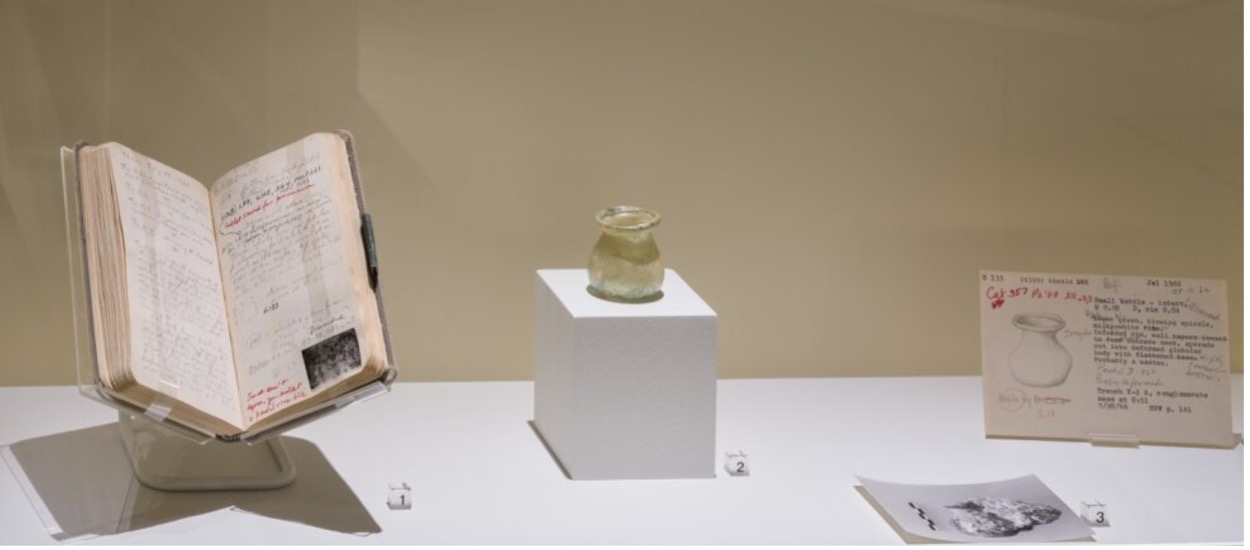Ancient Jalame Revisited
By Benton Kidd, Ph.D., Curator of Antiquities
No ancient glass factory had been systematically excavated by the 1960s, but there was mounting opinion that the southern Levant (Lebanon, Israel, Egypt) was a major glass production center in the Hellenistic and Roman periods. The reason was that the region had the extraordinary cocktail of ingredients necessary to make superlative glass: silica-rich sand, natron, and lime.
Gladys Weinberg, one of the founders of the Museum of Art and Archaeology, realized that an ancient glass workshop must be there awaiting discovery, and that idea finally became a reality on a hill known as Jalamet el-Asafna in northern Israel.
Beginning in 1964, the joint University of Missouri-Corning Museum of Glass excavation, directed by Weinberg, revealed the site of a Late Roman glass factory, which had begun operation in the fourth century CE.
“Jalame” (as Weinberg rechristened it) became pivotal to understanding ancient glass manufacture and the role of the Levantine coast as a major production center. A full publication of the site followed in Excavations at Jalame: Site of a Glass factory in Late Roman Palestine (Columbia, MO; 1988). Many of the finds, including pottery, glass, and other materials, are still housed at MU’s Museum of Art and Archaeology.
Weinberg had pioneered the study of ancient glass nearly 30 years earlier when she wrote her dissertation on the “small finds” of ancient Corinth, an excavation sponsored by the American School of Classical Studies in Athens where Weinberg (then Davidson) had become a Fellow. She would publish her dissertation research on the glass of ancient Corinth by the early 1950s, after relocating to Columbia for the appointment of husband Saul Weinberg to the Mizzou faculty.
By the end of the 1950s, the Weinbergs had an excavation on Cyprus and the foundation of the Museum of Art and Archaeology under their belt, but the discovery of Jalame would indelibly alter the trajectory of Gladys Weinberg’s career, and lead to her becoming an international authority on glass in antiquity.
Earlier this year, The Corning Museum of Glass in Corning, NY, launched the exhibition, Dig Deeper: Discovering an Ancient Glass Workshop, to recontextualize ancient Jalame and update its story sixty years later. An international collaboration between the US and Israel, with contributions from scholars in the UK and Denmark, the exhibition not only reexamines the operations of a 1600-year-old glassworks factory but also reveals new information about ancient glassmaking through recent excavations by the Israel Antiquities Authority and state-of-the-art scientific analysis of Jalame’s ancient glass vessels.
As one of the chief lenders to The Corning’s exhibition, the Museum of Art and Archaeology has contributed ancient glass vessels and fragments, in addition to Weinberg’s original excavation notebooks, sketches, and other paper archives. The Dig Deeper exhibition runs through January 7, 2024 at The Corning: https://whatson.cmog.org/exhibitions-galleries/dig-deeper-discovering-ancient-glass-workshop

In conjunction with their Dig Deeper exhibition, The Corning Museum of Glass produced an illustrated comic-style publication to appeal to readers 10 and older. Gladys Weinberg, one of the founders of MU’s Museum of Art & Archaeology, is featured in the booklet.

Included in The Corning Museum of Glass’s Dig Deeper exhibition are, from left, one of Gladys Weinberg’s field notebooks, a small pale bluish-green blown glass jar from the Jalame excavations, a photo of the vessel, and its inventory card, all on loan from MU’s Museum of Art & Archaeology.